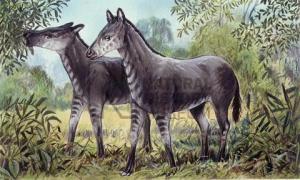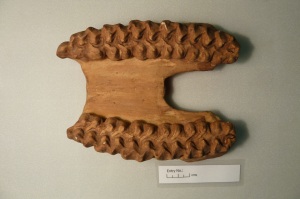After a small hiatus, the infamous bad casts are back in their usual chipped, crap manner. And, as you would expect, this one fails to impress. What looks like a somewhat expensive exfoliator, is in fact a cast of a real fossil. I have no doubt it would be a very satisfying exfoliator (particularly on your upper back), but I wouldn’t. Mainly because it is likely to crumble into mush in your hand if you soak it in water. But also because curators generally don’t take specimens with them into the bath. Well, most of the time we don’t.
The label has this bad cast identified as ‘Anchitherium’, which is italicised because this is the Genus of an animal. (We, for example, belong to the Genus Homo, and the species sapiens, so our scientific name is Homo sapiens). What is lovely (for me) is that there is more information on the card, saying it was cast from a specimen which is at the Muséum national d’Histoire naturelle, Paris. This is the first time in all the bad casts that I have written about that has information about the actual fossil it was cast from! This opens up new stories into discovering who collected the specimen, when and where from.
Anchitherium was a type of horse that lived from 25 million years ago to around 5 million years ago. It was quite unlike any horse you would see around today, for this creature was about the same size as a small labrador, and had three hooves on each foot. It was a very successful Genus with many different species, but it was not a direct descendent to horses around today. Little Anchitherium was a side branch that only just didn’t make it.

The little horse, Anchitherium, just browsing on some leaves. (Image from here)
This unusual horse was more at home in the woods than on grasslands, which would ultimately lead to its demise. Evolving in North America, changes in climate caused woodlands to shrink, and additional competition pushed Anchitherium out to migrate towards Europe and Asia. Fossils of Anchitherium species have been found in Japan dating from around 16.5 million years ago.
This may not look like much, but it was cast from quite an awesome animal. The cast is from the top teeth showing the glorious exfoliating bumps beautifully. These bumps tell us what the animal ate. At home in woodlands, the bumpy bits (called the crowns) are higher than those in modern horses, showing us that it ate plants and leaves instead of grasses. These specialist teeth couldn’t adapt quick enough to changing temperatures, vegetation and competition. Anchitherium was a specialist plant eater; too specialist to adapt as the areas it lived lost its woodlands. As the woodlands vanished, so did this little horse. This little three toed creature was replaced by luscious grass plains, and different kinds of horses. Including the ancestors of the horse we have today.

